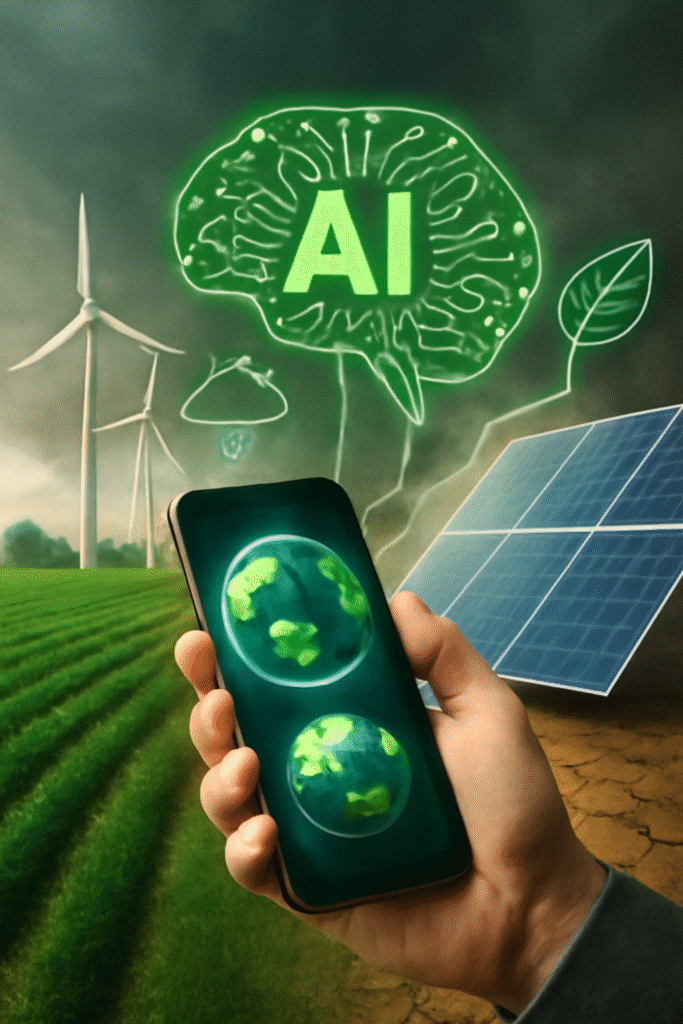O planeta enfrenta um dos seus maiores desafios: a crise climática.
Provavelmente já ouviu falar sobre poluição, desflorestação e aquecimento global.
Todas essas mudanças afetam a natureza, os animais e até mesmo o funcionamento das nossas cidades. Mas há um lado encorajador: pessoas de todo o mundo estão a se unir para imaginar soluções.
E agora temos um aliado especial — a tecnologia verde impulsionada pela Inteligência Artificial (IA).
No entanto, mais do que tudo, o progresso real depende da colaboração humana. Cada ação individual é importante, e a tecnologia se torna uma ferramenta poderosa quando guiada pelo nosso propósito coletivo.
O que é tecnologia verde?
A tecnologia verde refere-se a inovações concebidas para proteger, restaurar ou preservar o ambiente.
Inclui ferramentas e invenções que reduzem a poluição, poupam energia e evitam o desperdício.
Pode assumir a forma de um programa informático que minimiza o consumo de energia, uma máquina que purifica rios ou um sistema que monitoriza florestas inteiras.
Quando combinadas com a IA, estas ideias tornam-se ainda mais precisas e eficientes.
Já viu algum projeto criado para ajudar o planeta? Qual deles o inspirou mais?
E na sua vida diária, que pequenos hábitos poderia mudar para ajudar a natureza a prosperar?
Como a IA ajuda a combater a crise climática

A inteligência artificial funciona como um enorme cérebro coletivo — aprendendo padrões, analisando fluxos infinitos de informação e ajudando os seres humanos a tomar melhores decisões.
Embora poderosa, a IA só tem significado visto que as pessoas que a projetam, mantêm e melhoram lhe dão significado.
O progresso surge da combinação da tecnologia e da humanidade trabalhando juntas.
Aqui estão algumas maneiras pelas quais a IA — guiada por comunidades humanas — está a transformar o planeta:
1. Monitorização florestal e controlo do desmatamento
Satélites, drones e câmaras baseadas em IA permitem que os cientistas observem os ecossistemas florestais em tempo real.
Eles podem detectar o abate ilegal de árvores, incêndios florestais ou sinais de stress no ecossistema com antecedência suficiente para que os governos e grupos locais possam responder rapidamente.
Por trás de cada sistema de rastreamento bem-sucedido estão inúmeros colaboradores — ecologistas, engenheiros, organizações sem fins lucrativos e comunidades indígenas — trabalhando em sincronia para proteger os habitats naturais.
Você consegue imaginar como seria difícil proteger uma floresta do tamanho da Amazônia sem tecnologia?
De que outras maneiras criativas as pessoas e a tecnologia poderiam se unir para proteger os tesouros naturais da Terra?
2. Prever catástrofes naturais
Ao analisar dados sobre precipitação, padrões de vento e condições do solo, os modelos de IA podem prever inundações, tempestades e secas com antecedência.
Isso permite que regiões inteiras se preparem, salvando vidas e reduzindo danos.
Meteorologistas, cientistas de dados e voluntários cooperam para transformar informações em planos acionáveis.
Quão mais seguras as comunidades poderiam se tornar se elas soubessem

Todo sistema de IA depende de muitas mãos — pessoas que projetam, ajustam, questionam e melhoram em conjunto.
A inteligência coletiva é sempre mais forte do que a inteligência artificial sozinha.
Pense na IA como um instrumento poderoso que só faz sentido quando guiado por um propósito.
A tecnologia existe para servir à humanidade, não para substituí-la.
Por que acredita que o trabalho em equipa é tão crucial ao abordar um desafio global como as alterações climáticas?
Gosta de aprender com os outros — trocando ideias, ensinando e crescendo como um grupo?
Exemplos de ação ambiental coletiva
Campanhas de limpeza: voluntários usam aplicações de IA para localizar rios poluídos e organizar eventos coletivos de restauração.
Projetos de ciência cidadã: estudantes, famílias e investigadores recolhem dados sobre biodiversidade que alimentam ferramentas de IA para mapear espécies e ecossistemas.
Educação ambiental digital: professores e alunos criam jogos interativos, workshops online e experiências narrativas usando plataformas baseadas em IA que tornam o aprendizado sobre o clima empolgante e prático.
O papel de cada um na construção de um futuro mais verde
Pode perguntar-se: «Uma pessoa pode realmente fazer a diferença?»
A resposta é sim — todas as grandes mudanças ambientais começam com ações pequenas e consistentes.
Quando as pessoas ouvem, unem-se e cooperam, ocorre uma transformação real.
A IA pode ajudar-nos a analisar e compreender os problemas, mas os seres humanos devem decidir como responder com empatia e coragem.
Que ação simples poderia tomar hoje para cuidar do planeta?
E se convidasse amigos, professores ou familiares para participar num projeto ecológico — como os inspiraria a participar?
IA inovação importa menos do que as intenções por trás dela.
O que realmente impulsiona a mudança são os valores — generosidade, respeito, honestidade e cuidado mútuo.
As melhores tecnologias ambientais nascem quando as pessoas sonham juntas, acolhem diferentes perspectivas e compreendem que o progresso e a compaixão são inseparáveis.
A inteligência artificial pode processar milhares de milhões de pontos de dados, mas a compaixão, a justiça e a empatia continuam a ser exclusivamente humanas.
O respeito pela vida, a colaboração entre diferenças e o amor pelo planeta são os verdadeiros motores da transformação.
Que valores — justiça, solidariedade, curiosidade, coragem — considera mais importantes na criação de tecnologia que sirva a Terra?
E como as suas próprias decisões podem inspirar outros a agir também?

O futuro do nosso planeta depende de todos nós.
Imagine um amanhã com rios limpos, florestas exuberantes e cidades movidas a energia renovável — um mundo onde máquinas inteligentes apoiam pessoas dedicadas a proteger a vida na Terra.
Esse futuro só existirá se continuarmos a aprender uns com os outros, a trabalhar juntos e a acreditar que a ação coletiva é importante.
Cada escolha conta.
Seja usando IA para orientar a agricultura sustentável, alertar comunidades sobre tempestades ou ensinar crianças sobre consciência ambiental —
O caminho a seguir depende da tecnologia e da humanidade caminhando lado a lado.
Como você acha que o mundo poderia ser daqui a 20 anos se realmente uníssemos ciência e compaixão para combater a crise climática?
Que tipo de beleza, paz ou equilíbrio você sonha em ver em um planeta mais saudável?
